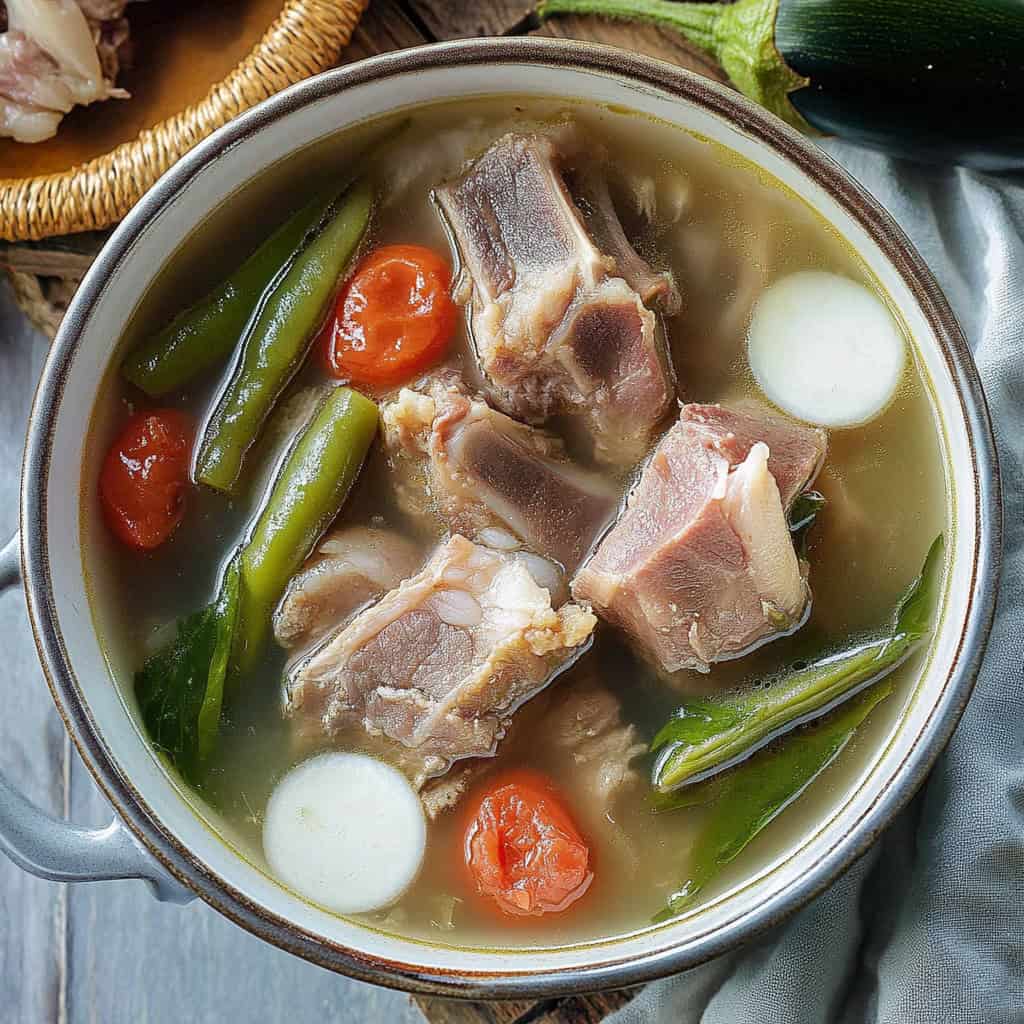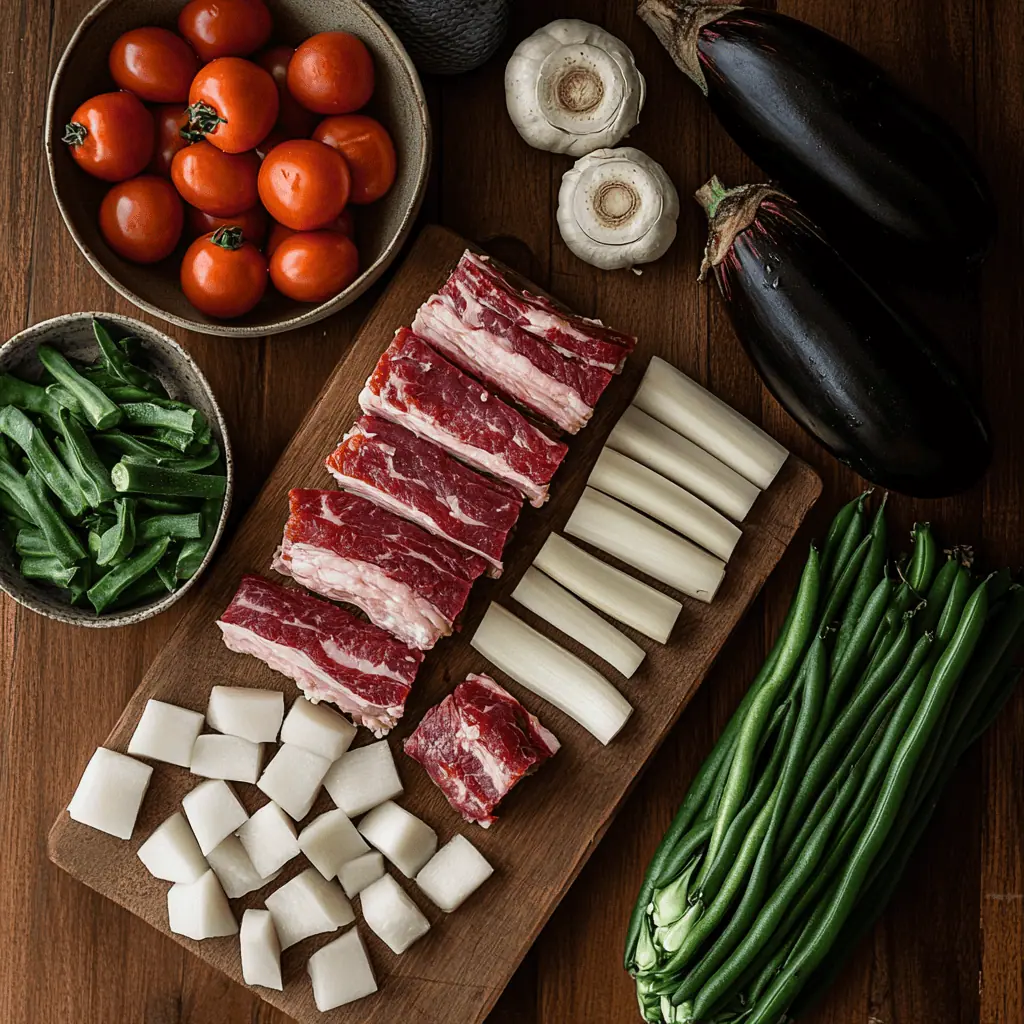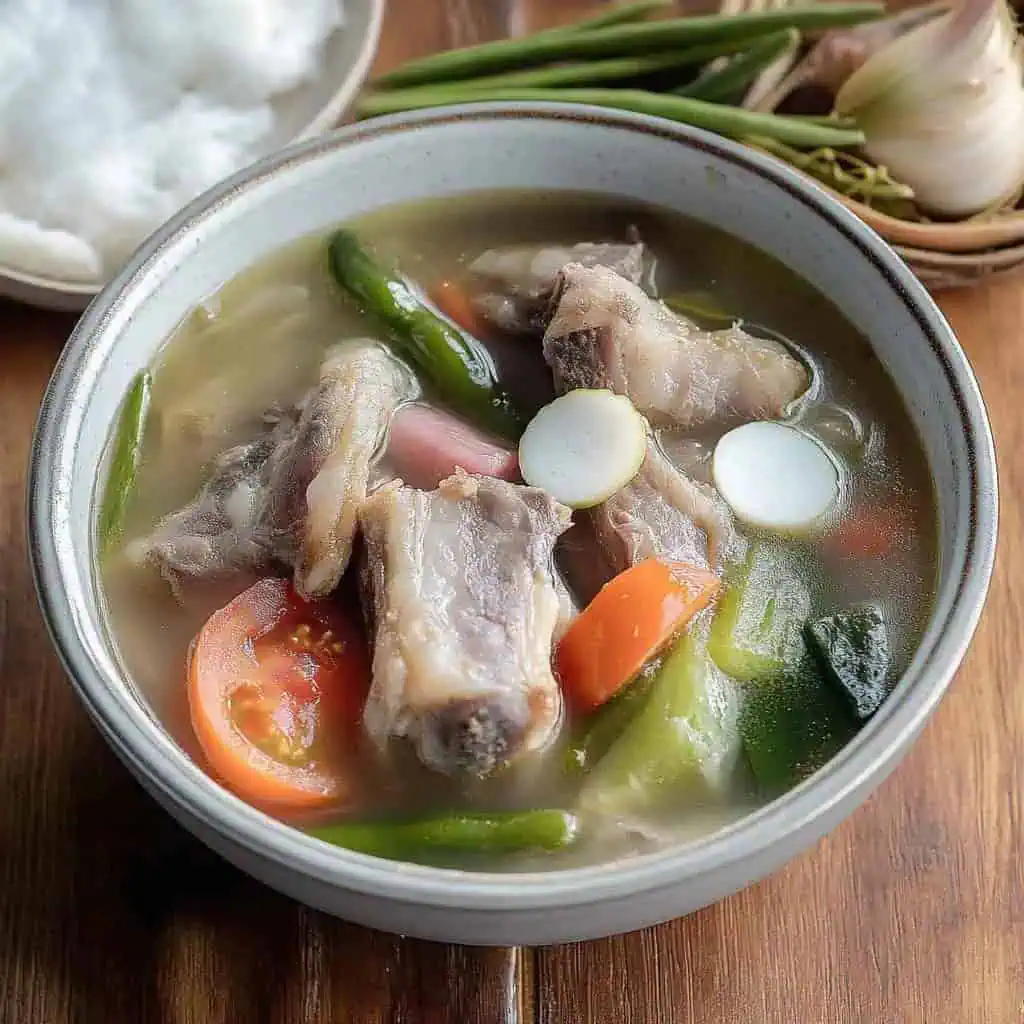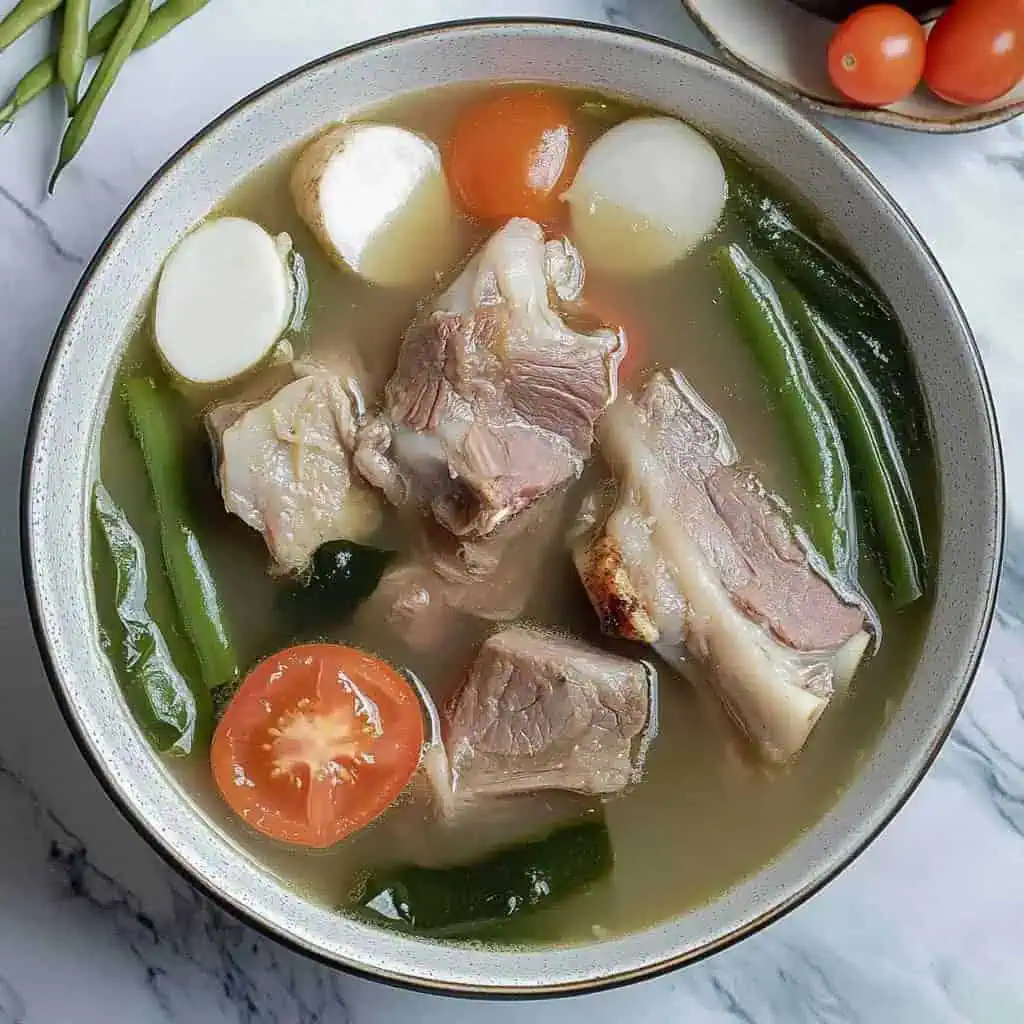You know those rainy afternoons when the sound of droplets hits your tin roof, and your Nanay somehow knows exactly what you're craving? That's when the familiar clinking of her favorite kaldero signals that sinigang is on the way. Whether you're nursing the sniffles, coming home from a long day at work, or just missing the taste of home, nothing quite hits the spot like a steaming bowl of sinigang na baboy.
This isn't just soup – it's a warm hug in a bowl that every Filipino knows by heart. The moment that sour-sweet aroma of tamarind fills your kitchen, you can already taste the tender pork falling off the bones, the satisfying crunch of gabi, and that perfect sawsawan of patis with sili that makes your nose run just a little.
Some fancy restaurants might serve it, but we all know the best sinigang is the one that reminds you of home – the kind where you fight over the last piece of liempo, where the sabaw is so good you drink it straight from the bowl (when no one's looking), and where there's always extra rice ready for that second round.
This recipe might not be exactly like your mom's secret version (because let's be honest, nothing ever will be), but it comes pretty close to that comforting taste we all grew up with.
Jump to:

Why You'll Love This Recipe
- Perfect Balance: Master the signature sour-savory taste that makes sinigang irresistible
- Authentic Method: Time-tested techniques passed down through generations
- Clear Instructions: Step-by-step guidance with Tagalog translations
- Foolproof Results: Detailed troubleshooting tips ensure success
- Health Benefits: Packed with nutrients from fresh vegetables and lean protein
Ingredients
Each ingredient in Sinigang na Baboy serves a specific purpose in creating the perfect Filipino sour soup. Tamarind delivers the signature tanginess that defines sinigang, while pork ribs or belly provide rich flavor and satisfying protein.
The colorful mix of vegetables, from hearty taro that thickens the broth to crisp bok choy added at the end, creates contrasting textures and balanced nutrition. Tomatoes and onions build the soup's savory foundation, while fish sauce adds that crucial umami depth.
The careful selection and timing of these ingredients work together to create a dish that's simultaneously nourishing, flavorful, and authentically Filipino: a perfect balance of sour, savory, and comforting elements that has made this soup beloved for generations.

For the Soup Base:
- 2 pounds pork spare ribs or pork belly (liempo), cut into 2-inch pieces
- 8 cups water
- 15 pieces fresh tamarind (sampalok) or 1½ packages (1.41 ounces each) tamarind powder
- 2-3 tablespoons fish sauce (patis)
- Salt and freshly ground black pepper to taste
Vegetables:
- 2 large ripe tomatoes (kamatis), quartered
- 1 medium red onion (sibuyas), peeled and quartered
- 6 pieces taro root (gabi), peeled and halved
- 1 daikon radish (labanos), 6-inch length, sliced diagonally into ½-inch pieces
- 2 finger chilies (siling haba)
- ½ bunch long beans (sitaw), cut into 2-inch lengths
- 1 medium Asian eggplant (talong), sliced diagonally
- 6 pieces okra, ends trimmed
- 1 bunch bok choy (pechay), leaves separated from stems
Equipment
- Large pot or Dutch oven (kaldero) - Provides enough space for the broth and all vegetables to cook evenly without overcrowding
- Long-handled wooden spoon (sandok) - For gentle stirring without breaking up vegetables
- Mesh skimmer or slotted spoon (siyanse) - Essential for removing scum that rises to the surface, ensuring a clear broth
- Sharp chef's knife and cutting board - For precise cutting of vegetables and meat
- Vegetable peeler - Makes quick work of preparing taro, radish, and other root vegetables
- Mortar and pestle (dikdikan) - If using fresh tamarind, this helps extract maximum flavor
- Fine mesh strainer - For straining fresh tamarind pulp to achieve a smooth broth
- Ladle (sandok pangsabaw) - For serving the finished soup
- Small dipping bowls - For individual patis (fish sauce) condiments

How To Make
- Preparation: Organize your workspace and gather all ingredients. Rinse the pork ribs thoroughly under cold water, pat them dry with paper towels, and cut into 2-inch pieces.
- Building the Broth: Pour 8 cups of water into your large pot and place over high heat. Add the cleaned pork and bring to a full boil. Once boiling, reduce heat to medium (180°C/350°F) and use your skimmer to remove any foam that forms on the surface—this is crucial for achieving a clear, beautiful broth.
- Developing Flavor: While the meat begins cooking, prepare your vegetables. Add the quartered onions and tomatoes to the pot with the pork. Let everything simmer for 30 minutes or until the pork starts to become tender.
- Adding Umami: Pour in the fish sauce (patis) and continue simmering for 15 more minutes to allow the flavors to meld.
- The Sour Element: Add your tamarind base. If using fresh tamarind, combine the pulp with 1 cup of warm water, mash well using a mortar and pestle, and strain through a fine mesh strainer. If using powder, dissolve it in 1 cup of warm water before adding to the pot.
- Vegetable Sequence: Add vegetables in stages to ensure perfect doneness:
- First, add taro and cook for 6 minutes
- Next, add daikon radish and cook for 3 minutes
- Add finger chilies and cook for 2 minutes
- Long beans go in next for 2 minutes
- Add eggplant and okra together and cook for 2 minutes
- Finally, add the bok choy and cook for just 1 minute
- Final Seasoning: Taste your soup and adjust the flavors. Need more sourness? Add tamarind. Want it saltier? Add fish sauce. Finish with freshly ground black pepper to taste.
- Resting Period: Let everything rest for 5 minutes after turning off the heat. This crucial step allows the flavors to fully develop and harmonize.
- Serving: Ladle the hot soup into individual serving bowls and serve immediately with steaming white rice. Prepare small dishes of fish sauce with calamansi and bird's eye chilies (siling labuyo) on the side for each diner to customize their bowl's flavor.

Tips From Lola's Kitchen
- Meat Selection: Choose pork cuts with bones attached (like ribs or neck bones) for a richer, more flavorful broth. The collagen from the bones creates depth that boneless cuts can't match.
- Parboiling Technique: For exceptionally clear broth, place the pork in cold water, bring to a boil for 2 minutes, then discard this water. Rinse the meat, clean the pot, and proceed with fresh water.
- Flavor Development: Never rush the initial simmering stage with the meat, onions, and tomatoes, this builds the foundational flavor.
- Vegetable Integrity: Never cover the pot while cooking to maintain the vegetables' vibrant color and prevent overcooking.
- Tasting Discipline: Always taste before adding more tamarind or fish sauce. It's easier to add more than to fix an overpowered broth.
Substitutions
Meat Options:
- Pork Belly (Liempo): Richer flavor with more fat marbling
- Pork Shoulder (Kasim): More meat, less fat, still tender when properly cooked
- Pork Hocks (Pata): Gelatinous texture with skin that adds richness
- Pork Ribs: Perfect balance of meat and bones for flavor
Souring Agents:
- Calamansi: Produces a lighter, citrusy sour profile
- Kamias (Bilimbi): Creates a sharper sourness than tamarind
- Green Mango: Offers a fruity sourness with subtle sweetness
- Guava (Bayabas): Milder sourness with floral notes
- Batwan: Used commonly in Visayan regions for a distinctive sour flavor
Vegetable Substitutions:
- Water Spinach (Kangkong) instead of bok choy
- Mustard Greens (Mustasa) for a peppery note
- Sweet Potato can replace taro for a different starchy component
- String Beans or Snake Beans in place of long beans
- Zucchini as an alternative to eggplant
Other Substitutions:
- Sea Salt can replace fish sauce (though you'll lose some umami)
- Lemon Juice in place of tamarind (as a last resort)
- Vegetable Broth instead of water for a deeper foundation (non-traditional)
Troubleshooting
Soup Isn't Sour Enough
- Solution: Add more tamarind powder gradually, 1 teaspoon at a time
- Alternative: Squeeze fresh calamansi directly into the broth
- Prevention: Fresh tamarind generally provides more consistent sourness than powder
Meat Is Too Tough
- Solution: Continue simmering on low heat for 30-45 additional minutes, adding hot water if needed to maintain broth level
- Prevention: Choose younger pork cuts or use pressure cooker to tenderize meat faster
- Tip: Cut meat into smaller pieces for quicker cooking
Broth Is Cloudy
- Solution: Unfortunately, this can't be fixed mid-cooking. Serve as is, flavor remains unaffected
- Prevention: Skim diligently at the beginning, avoid rapid boiling, and don't stir too vigorously
- Pro Tip: The parboiling method mentioned in tips virtually eliminates this issue
Vegetables Are Mushy
- Solution: For current batch, nothing can be done. However, for serving the next day, cook fresh vegetables separately and add to reheated broth
- Prevention: Follow the vegetable sequence strictly, timing each addition
- Remember: Vegetables continue cooking even after heat is turned off
Broth Reduced Too Much
- Solution: Add hot water (not cold) ¼ cup at a time until desired level is reached, then adjust seasonings
- Prevention: Maintain gentle simmer rather than vigorous boil
- Note: If adding significant amounts of water, you'll need to boost flavor with additional fish sauce and tamarind
Storage & Reheating
Refrigeration
- Store in airtight containers for up to 3 days
- For best results, separate vegetables from broth and meat if storing more than 24 hours
- Cool completely before refrigerating (within 2 hours of cooking)
Freezing
- Freeze broth and meat for up to 2 months in freezer-safe containers
- Do not freeze with vegetables—they become mushy when thawed
- Leave 1-inch headspace in containers to allow for expansion
Reheating
- Stovetop: Heat slowly over medium-low until internal temperature reaches 165°F (74°C)
- Add fresh vegetables to frozen/refrigerated broth during reheating for best texture
- Never microwave sinigang, it cooks vegetables unevenly and affects broth clarity

FAQ
Can I use a slow cooker or Instant Pot?
Yes! For slow cooker: Cook on low for 6-8 hours. Add vegetables during final 1-2 hours based on their cooking times. For Instant Pot: Pressure cook meat with onions and tomatoes for 25 minutes, then add vegetables using sauté function in proper sequence.
Can I make this dish vegetarian?
Absolutely. Replace pork with firm tofu, mushrooms, or both. Use vegetable broth instead of water and salt instead of fish sauce. The dish will have a different character but still capture the essential sour profile of sinigang.
Why is my broth cloudy despite careful skimming?
Rapid boiling can cause proteins to break down and cloud the broth. Always maintain a gentle simmer. Additionally, stirring too vigorously can cause cloudiness. Use a gentle folding motion when adding ingredients.
Can I use instant tamarind powder?
Yes, but fresh tamarind provides better depth of flavor. If using powder, start with 75% of the recommended amount and adjust to taste. Some brands are more concentrated than others.
What's the best rice to serve with sinigang?
Freshly steamed jasmine rice is traditional. The slightly sticky texture and floral aroma complement the sour broth perfectly. Short-grain rice is also excellent as it absorbs the broth nicely.
Is sinigang healthy for people with dietary restrictions?
The basic recipe is naturally gluten-free and dairy-free. For low-carb diets, omit the taro and limit root vegetables. For low-sodium needs, reduce fish sauce and use fresh herbs to boost flavor instead.
How do I know when the meat is perfectly cooked?
Properly cooked pork should be tender enough that it begins to pull apart with gentle pressure from a fork, but not so soft that it's falling apart completely. The meat near the bone should show no pinkness.
Why do vegetables need to be added in sequence?
Each vegetable has a different fiber structure and density, requiring different cooking times. Following the sequence ensures every component reaches ideal tenderness without some becoming mushy while others remain undercooked.
What can I do with leftover sinigang?
Beyond simple reheating, strain and use the broth as a cooking liquid for rice (sinangag na sinigang), reduce it for a sauce over grilled meats, or use it as a poaching liquid for fish. The meat can be shredded for sinigang fried rice.
Related
Looking for other recipes like this? Try these:

Authentic Sinigang na Baboy
Ingredients
For the Soup Base:
- 2 pounds pork spare ribs baboy, cut into 2-inch pieces
- 8 cups water
- 15 pieces fresh tamarind sampalok or 1½ packages (1.41 ounces each) tamarind powder
- 2 tablespoons fish sauce patis
- Salt and pepper to taste
Vegetables:
- 2 large tomatoes kamatis, quartered
- 1 medium onion sibuyas, peeled and quartered
- 6 pieces taro root gabi, peeled and halved
- 1 daikon radish labanos, 6-inch length, sliced
- 2 finger chilies siling haba
- ½ bunch long beans sitaw
- 1 medium eggplant talong
- 6 pieces okra
- 1 bunch bok choy pechay
Instructions
- Start by preparing your workspace and gathering all ingredients. This will make the cooking process smoother (Ihanda ang lahat ng sangkap para sa maayos na pagluluto).
- Take your pork ribs and rinse them thoroughly under cold water (hugasan ng mabuti ang baboy sa malamig na tubig). Cut the meat into 2-inch pieces (hatiin ang karne ng dalawang pulgada) and pat them dry with paper towels (patuyuin gamit ang paper towel).
- Pour 8 cups of water into your large pot (maglagay ng 8 tasang tubig sa kaldero). Place the pot over high heat and add the cleaned pork. Bring everything to a boil (pakuluin sa malakas na apoy).
- Once the water is boiling, reduce the heat to medium (180°C/350°F). You'll see foam forming on top - use your skimmer to remove this scum. This step is crucial for achieving a clear broth (para luminaw ang sabaw).
- While waiting for the meat to cook, prepare your vegetables (ihanda ang mga gulay). Quarter your onions (sibuyas) and tomatoes (kamatis). Peel and cut the taro (balatan at hatiin ang gabi) into 2-inch pieces. Slice the daikon radish (labanos) diagonally. Cut the long beans (sitaw) into 2-inch lengths. Slice the eggplant (talong) diagonally. Clean the okra and trim the ends. Separate the bok choy leaves from stems (ihiwalay ang dahon ng pechay sa tangkay).
- Add the quartered onions and tomatoes to the pot. Let everything simmer for 30 minutes or until the pork starts to become tender (palambutin ang baboy).
- Pour in the fish sauce (patis) and continue simmering for 15 more minutes (pakuluan ng kinse minutos).
- Now add your tamarind base (sampalok). If using fresh tamarind, combine the pulp with warm water, mash well, and strain (durugin ang sampalok at salain). If using powder, follow package instructions.
- Begin adding your vegetables in this order (magdagdag ng gulay ayon sa pagkakasunod-sunod). Add the taro first and cook for 6 minutes. Next goes the daikon radish - give it 3 minutes. Add finger chilies and cook for 2 minutes. The long beans go in next for 2 minutes. Add eggplant and okra together and cook for 2 minutes. Finally, add the bok choy and cook for just 1 minute.
- Taste your soup (tikman ang sabaw) and adjust the flavors. Need more sourness? Add tamarind (dagdagan ng sampaloc). Want it saltier? Add fish sauce (dagdagan ng patis). Finish with black pepper to taste (paminta).
- Let everything rest for 5 minutes after turning off the heat (palamiginin ng 5 minuto pagkatapos patayin ang apoy). This helps the flavors come together (para mas masarap).
- Pour your hot soup into serving bowls (ilagay sa mangkok) and serve immediately with steaming white rice (mainit na kanin). Prepare small dishes of fish sauce with calamansi (sawsawan) and chilies (siling labuyo) on the side for each diner to customize their bowl's flavor.
For best results (Para sa pinakamasarap na sinigang):
- Maintain a gentle simmer throughout cooking (panatilihing mahina ang apoy)
- Don't overcook the vegetables (huwag lutuing masyado ang gulay)
- Taste and adjust seasonings gradually (unti-unting tikman at ayusin ang lasa)
- Add more hot water if the broth reduces too much (magdagdag ng mainit na tubig kung kumaunti ang sabaw)
Tips from Lola's Kitchen
- Choose meat with bones for richer broth (buto-buto)
- For clearer broth, parboil the meat first
- Never cover the pot while cooking to maintain the vegetables' vibrant color
- Add leafy greens last to keep them crisp
- Taste for sourness before adding more tamarind
Nutrition
The Story Behind Sinigang na Baboy
Sinigang na Baboy stands as the ultimate comfort food in Filipino cuisine, representing the culture's deep love for sour soups. What makes this pork sour soup extraordinary isn't just its flavor—it's how perfectly it captures the Filipino palate's remarkable appreciation for asim (sourness). While other Asian cuisines might feature sour notes, Filipinos elevated sourness into an art form, and sinigang sits proudly at the pinnacle of this tradition.
The genius of sinigang lies in its adaptability and regional diversity. Originally made with native sampalok (tamarind), Filipino cooks across generations have crafted versions using other souring agents like kamias, batwan, bayabas (guava), and green mango, depending on local availability. Each souring agent brings its own character to the dish, but they all serve the same purpose: creating that distinctive lip-smacking sourness that cuts through the richness of tender pork. The addition of vegetables like gabi (taro), kangkong (water spinach), radish, tomatoes, and eggplant transforms it into a complete, nourishing meal that's perfect for rainy days or any time Filipinos crave the taste of home.
Today, while instant sinigang mixes have made this dish more accessible, traditional home-cooked sinigang remains unmatched in its ability to deliver comfort and satisfaction. Whether served in humble carinderias or upscale Filipino restaurants, sinigang na baboy continues to prove why it's considered one of the Philippines' best-loved dishes—a perfect representation of Filipino taste that's simultaneously sophisticated and down-to-earth.
Remember: The mark of perfect sinigang isn't just in its sourness, but in finding that sweet spot where the soup is sour enough to make you smile but balanced enough to keep you coming back for more.










Dwightmum says
I didn't know about this dish until I read it here. Tried it and it's delicious.
BennyRhymn says
I love how sour it is
JamesEdutt says
First time to cook this dish. It was challenging but worth it.